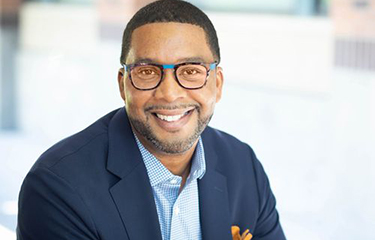Tony Byers: Diversity, equity, inclusion can lead seafood industry to greater success

Businesses are seeing less turnover, growth in market share, and more robust earnings through the implementation of diversity and inclusion (D&I), according to Tony Byers, who has spent more than two decades immersed in the field, which he believes to be “the business imperative of our time.”
Author of the book “The Multiplier Effect of Inclusion: How Diversity and Inclusion Advances Innovation and Drives Growth,” and former director of global diversity and inclusion for Starbucks, Byers has extensive firsthand knowledge of D&I’s significant impact on the business world over the past 20-plus years. Byers said he intends to share many of his insights with the seafood industry during his Seafood Expo North America Reconnect keynote address on Wednesday, 17 March, from 10 to 11 a.m. EDT.
Billions of dollars have been spent on D&I initiatives, and some of the latest data-points make it obvious as to why. According to a Boston Consulting Group (BCG) study, organizations with diverse management teams have 19 percent higher revenues due to enhanced innovation. Moreover, separate research compiled by Coqual – formerly the Center for Talent Innovation – found that employees at companies with comprehensive D&I approaches were “45 percent likelier to report that their firm’s market share grew over the previous year, and 70 percent likelier to report that the firm captured a new market,” researchers wrote in a 2013 Harvard Business Review article.
Recalling the early days of D&I, Byers told SeafoodSource that just one letter in the acronym existed at the time.
“If you rewind 15 to 20 years ago, when organizations were thinking about the subject of diversity, they were considering it as more of a counting of the number of people who were different,” he said.
A decade in, Byers said the concept of "inclusion" made its debut.
“What you started to see is the subject evolve over the last 10 years, moving from just diversity, to diversity and inclusion,” Byers said. “Diversity in and of itself is not going to get you the benefits you want if you don’t have an inclusive environment. Organizations were doing all they could to hire people so that they could show that they had diversity. But then they found, on the back-end, that they were losing a lot of people to turnover because they didn’t have the environment that supported or created opportunities for people who come from different backgrounds, or perspectives, or identities.”
Currently, Byers said an additional concept is being absorbed into the D&I landscape: equity.
“What we’re starting to see in the marketplace right now is this concept called ‘equity.’ Equity is an additional build focused on equal access toward opportunities inside of organizations and systems,” he said.
Each piece helps fortify and advance the whole, according to Byers. While diversity asks “do you have people,” inclusion considers if a business has “an environment that treats those people well,” he said. Equity, meanwhile, deals with whether an organization “creates equal opportunity for the people who are different to have access to be able to participate.”
While all types of companies and organizations can be “effective in this space,” Byers said how an entity acts on D&I depends on a variety of factors, including whether it’s a nonprofit or for-profit organization, if it’s a business-to-business or business-to-consumer operation, and how long it’s been on its D&I journey.
“Each of those organizations might look at the same categories, but the way that they activate – the actions or initiatives that they take – will look different,” he said.
Framing D&I
Regardless of business structure, an overarching framework consisting of four pillars tends to shape most D&I initiatives, Byers noted.
The first step in the universal D&I framework is workforce, which “examines the make-up of the people that you have in your organization at all levels, from your frontline workers to your senior leadership,” Byers said.
Byers said the second pillar, workplace, carries with it a cultural or environmental focus, where “you start to look at the training, the support mechanisms, the infrastructure that you have that creates an environment that values your diverse workforce.”
Once an organization has a good handle on its workforce and workplace in terms of D&I, success in the marketplace – the third pillar – tends to follow, according to Byers.
“The marketplace is where you take ideas, where you get increased performance or sales, where you have new products and/or services – that all happens when you do the other two things well,” he said.
Up until recently, those three spheres “have been the initial framework for thinking about the subject of diversity and inclusion,” Byer said. This year, however, a new element has been added.
“What we see now that’s relatively new is this fourth area, which talks about social [engagement] or community,” he said. “We’ve seen this a lot over the last year, where organizations are now saying ‘what we’re doing is contributing in a social way, we’re good social stewards, we believe in equity and equality for all people, and how we make that come to life is through our social diversity efforts.’”
Companies are pursuing this part of the framework, Byers said, through contributions to schools and social justice organizations, and by “leveraging business and providing training or services to people who are financially or economically disadvantaged.”
Ripple effect
When a seafood business adopts and commits to D&I, and it reaches the marketplace arena, its influence on supply chains can be significant, Byers explained.
“When very effective D&I initiatives are implemented inside of organizations and industries, what you see is other organizations wanting to be just as effective, or to capitalize on it, too,” he said. “If a seafood company is successful in its D&I initiative all the way through to the third stage that we call marketplace, and they start having an increase in sales – capturing new customers and new demographics that haven’t been captured before – what every organizations sees is an opportunity for growth.”
That said, a great deal of thought and effort has to occur before companies reap new customers and other marketplace perks, according to Byers.
“If you haven’t spent any time thinking about what the diversity of your workforce looks like, or how to reach out to different markets, or how your current employees can leverage their diverse perspectives in order to help you grow, then you’re not going to be able to capture this new market or these expanding market opportunities,” Byers said.
And once you’re late to the marketplace, he added, “you miss out on the opportunity for incredible growth.”
Ultimately, when an organization opens up to diversity and inclusion, the gains overpower any potential losses, Byers said.
“Sad to say, there are still people who look at another organization and say, ‘That organization is open to diversity [so] I don’t really want to buy food from them,’” he said. “That might be true, but I guarantee you, that there are a lot more people who make decisions about purchasing from customers or from their suppliers based on whether or not that organizations aligns with their values.”
Among the additional positives sown by thorough D&I efforts is brand loyalty, Byers said.
“What we know is that trust leads to loyalty. And when you’re trying to capture new markets, particularly when those markets come from diverse groups, cultures, or individuals of color, they have a tendency to be brand-loyal. That brand loyalty happens because of trust and engagement,” he said.
The coming COVID toll
Byers warned of D&I consequences to come from the COVID-19 pandemic, as “people make different decisions about their work-life balance or just their life balance” amid the unprecedented moment. Of particular concern are women in the workforce.
“All the data that we’re seeing right now shows women being adversely impacted by the loss of job roles in the marketplace,” Byers said.
These role reductions can be attributed somewhat to “organizations scaling back,” Byers said, as well as an increased volume of women choosing to “take care of their families because of loss of childcare,” changes in schooling, and more. He added that “women from African American or Hispanic backgrounds are suffering at a greater rate.”
Byers said he expects the seafood industry will feel the D&I ramifications of this shift years down the road.
“It affects decision-making that happens four years from now, five years from now, 12 months from now. There’s the impact right now, but then there’s the impact four years from now when I need to choose my next leadership person,” he said.
Men are more likely to stay within the workforce during the pandemic, even though they have families, too, Byers said, and therefore could be considered for a potential leadership spot over someone of a more diverse background who has chosen to exit the workforce for a time. Making decisions like these and thinking it has “nothing to do with diversity or gender,” will actually have everything to do with those two components considering “what’s happening right now,” according to Byers.
Key notes
Next week, Byers hopes seafood companies come away from his SENA Reconnect keynote understanding the value of D&I and their place in its continued evolution.
“I want them to understand the value of diversity and inclusion beyond that it’s the right thing to do,” he said. “I want them to think about the actions that they can do to make a contribution not only to their business and the industry, but also in terms of advancing the entire country and the world forward.”
It’s not hard to get on board with diversity and inclusion, nor is it difficult to make mistakes – but that’s all part of the process, Byers said.
“I want you to know it’s not hard, and it comes with you being willing to do something – it’s an engagement-type sport; you can’t do it from behind your desk. I don’t want you to be afraid, I want you to be willing to get it wrong or make a mistake every once in a while. I want you to learn and grow, and be able to do better because of it,” he said.
Photo courtesy of Tony Byers






Share